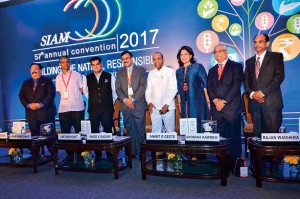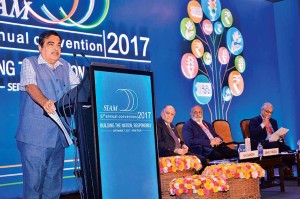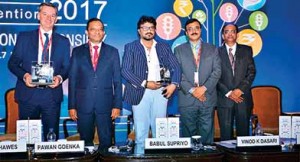SIAM’s annual convention stressed on a cleaner and greener future through ‘Design in India’ and ‘Make in India’.
Story by: Anirudh Raheja
With an eye on BSVI emission regulations slated to come in force from 2020, the SIAM annual convention held in Delhi recently provided a good image of where and how the Indian auto industry is moving. Apart from BSVI, the stakeholders of the industry stressed upon the need to pursue green technologies. The keynotes of the various industry leaders pointed in the direction of electric mobility as the goal. Elements like connected mobility were also spoken about. While the crude oil prices in international markets dipped to the half-way mark almost over the last three years, the prices of fuel in India have remained high. They rose significantly in the last few months after a decision was taken to link them every day to the price of crude oil in international markets. With discussion revolving around the fact that alternate fuel propulsion technologies need to be perfected as quickly as possible, SIAM stakeholders, at the 57th annual convention, called for all-round efforts to not only safeguard the future of mobility, but to also find new ways of working in the wake of new regulations.
Clear roadmap
Pointing at the disruptive phase the auto industry is currently facing, Vinod K. Dasari, the outgoing president of SIAM, and the managing director Ashok Leyland, expressed that the auto industry in India contributes to the GDP of the country, and to the needs of the defense forces for equipment. He mentioned that the auto industry generates 30 million jobs, and spends over 10 per cent of the country’s R&D. It also contributes 50 per cent of the manufacturing GDP, said Dasari. To gain more traction from the central government’s ‘Make in India’ initiative, Dasari called upon the automotive industry to emphasise on ‘Design in India’. He also urged the government to create a National Automotive Board to protect the auto industry. “Despite auto industry’s apprehension on how much R&D would be required to move from BSIV to BSVI, and whether fuel will be available or not, the auto industry has agreed to jump an entire emission regulation to align with what is in the best interest of the nation,” explained Dasari.
Stating that it is strange for SC to pass an order that no BSIII vehicles can be sold, Dasari averred that thousands of crores were lost by the industry. He expressed that authorities sometimes write directly to the transport ministry to ban certain type of vehicles. Claiming that it is the auto industry that is subjected to intense scrutiny for pollution problems, Dasari called for a need to speed up work on vehicle scrappage policies. He said that the auto industry will fully support the government for a clean and green tomorrow. Requesting clarity on auto policy, and a roadmap for regulations since the industry is facing unprecedented challenges and standing at the threshold of major transformation, Dasari stressed on the need for a collaborative effort from the industry that is supported by a vital regulatory mechanism.
Union Minister for Road Transport and Highways, Nitin Gadkari, in his speech, reiterated the need to reduce dependence on fossil fuels. He urged the industry to look for cleaner options. Pointing at the move to electric vehicles, Gadkari asked the industry to brace up for growing global competition to meet the rising challenges. “I want the industry to research and at least kick start. Once a costly affair, I called for you to start, and batteries are now cheaper by 40 per cent. Prices will go down once mass production is undertaken,” he said. Stating that his ministry is in favour of vehicles that pollute less, Gadkari mentioned that the cabinet note on electric vehicles is ready and aims to take care of the charging infrastructure.
The union minister expressed that whether willingly or not, everyone will be dragged towards cleaner emission vehicles. Emphasising upon alternate fuel technologies as the future, he mentioned, “I want the import bill and pollution to come down. The government has decided to start 15 industries for second-generation ethanol. Ethanol can be easily produced from agro-based cotton straw, wheat straw, rice straw, bagass and bamboo. Alternative fuel is an import substitute, and is cost effective.”
Manufacturing capability
Providing an assurance to the auto industry that the government is with them, Anant G Geete, Union Cabinet Minister for Heavy Industries and Public Sector Enterprises, expressed in his speech that the industry should brace itself to be competitive globally. Stating that he is aware of the auto industry facing a tough time, Geete drew attention to the production of BSVI engines and vehicles by the industry even though the BSVI emission norms are still some time away. “We are capable despite the non-availability of fuel, which means capability is not an issue,” he said. He quipped, “There are disruptions, and there is a need to safeguard the local industry too.” In his speech, Amitabh Kant, CEO of the NITI Aayog said that disruptions like electromobility and connected mobility are unavoidable whether the economy likes it or not. He stressed upon a policy regime to be predictable, consistent and clear. “The government should keep the auto industry at its arm’s length for faster growth,” he mentioned. Calling upon the industry and components manufacturers to gear up and not be left behind, Kant expressed that the challenge is to think through the current situation. “I want the policy to come from the industry, rather than from the government. The industry should tell about how it can brace up. It must speak one voice, and with strategy of create early impact to achieve full electric status in the long run,” averred Kant.
In his keynote address, Guenter Butschek, Chief Executive Officer, Tata Motors, expressed that the Automotive Mission Plan and Smart cities have had positive iimpact on the industry. The transition from BSIII to BSIV norms, GST and demonetisation, he said, have however caused disruptions in the market. In order to realise the true potential of Automotive Mission Plan 2026, there is a need to eradicate the deep rooted basic challenges within the overall ecosystem, accentuated by intermittent regulatory uncertainties, opined Butschek. Stressing upon the auto industry’s understanding of the regulatory issues, and the need to be in tune, Butschek stated that the industry is looking for a platform for collaborative and participative approach from the government for a policy framework that fosters sustainable growth. Drawing attention to India lagging in emission and safety norms implementation when compared to the rest of the world, Butschek called upon the need for OEMs to commit; to leverage the emerging trends, and to work in tandem to bridge the gap by investing in future technologies.
Talent
The annual convention also included a discussion on skill development and talent. Abhay Damle, Joint Secretary, MoRTH, expressed that India is not short on talent, there is however a need to carry out new research and development activities. He shared his observation that India is not keeping pace with the emission norms prevalent in the developed nations, and is buying new technologies from the world rather than developing them locally. “For faster growth of the industry, it is important to sell technologies, rather than to buy them. If we can stay one year ahead of the world, only then can we give technology to the world rather than take it from them,” said Damle. One of the ways to enhance ‘Design in India’ averred Damle is to put our engineering capabilities to the test. Appreciating the commitment shown by the industry in adapting to regulatory policies, he said positivity prevails in the Indian auto industry. The simple reason why the government makes regulations is to bring systematic reform, and to address problems at their source.
In his address, Vinod Aggarwal, Managing Director and CEO, Volvo Eicher Commercial Vehicles, mentioned that India has tremendous advantage in design and engineering. It can do things in a more relevant and frugal manner. Citing that the biggest advantage comes from competent engineers available at reasonable cost, Aggarwal stated that manufacturing excellence is extremely important, and should reason an investment in technology, skilled workforce, lean manufacturing, and in design and engineering to enhance asset productivity. “We need to bring automation in a balanced way; the need is to partner and develop more suppliers in India; develop world class quality to ensure process discipline,” he concluded.






















